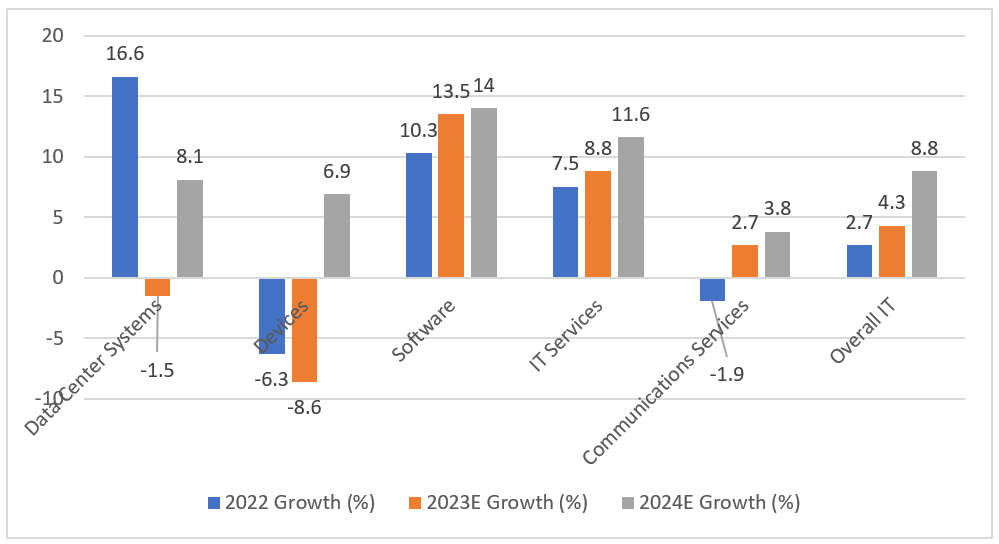For decades, the IT services industry has been a driving force behind the digital transformation of enterprises around the world. However, the years 2022 and 2023 has seen a significant slowdown in spending in this sector. This blog intends to shed light on the numerous elements leading to the slowdown and provide insights into the issues that the IT services industry is facing during these times.
In 2022, the total expenditure on IT amounted to $4.51 trillion, with a growth rate of only 2.7%, largely attributed to the slowdown and macro uncertainty. However, a recent report by Gartner, Inc. predicts that IT spending worldwide will increase by 4.3% in 2023, reaching $4.7 trillion. This trend is expected to continue with an estimated rise of 8.8% to approximately $5.12 trillion in 2024. The reason for this increase in spending is due to more companies prioritizing the adoption of technologies such as AI and Blockchain, which can automate processes and improve efficiency, allowing for larger-scale growth with reduced staff.
Overall IT spending



There are a number of factors that have contributed to the slowdown in the IT services industry. These include-
Impact of the COVID-19 Pandemic: The COVID-19 pandemic has undoubtedly disrupted businesses across all sectors, including the IT services industry. In 2022, the world was still dealing with the effects of the pandemic, which caused delays in IT projects, budget cuts, and decreased demand for services. Companies faced unprecedented hurdles in adjusting to remote work settings and assuring business continuity, leading to a conservative attitude to new IT investments.
Priorities shifting and budget constraints: During the slowdown, many organizations reassessed their priorities and allocated budgets accordingly. With the economic uncertainty brought by the pandemic, cost optimization became a primary concern for businesses. Consequently, IT services were often deprioritized in favor of core operations and immediate revenue generation. This shift in focus led to a reduction in IT spending, affecting the demand for IT services.
Skilled Talent Scarcity: To foster innovation and provide excellent services to clients, the IT services business significantly relies on a competent workforce. During the slump, however, the sector faced a twin problem. On the one hand, the pandemic interrupted the hiring and onboarding processes, making important roles difficult to fill. Emerging technologies, on the other hand, such as artificial intelligence, blockchain, and cybersecurity, created a demand for specialized talents that were in short supply. The industry’s capacity to scale and meet client demands was impeded by a skills shortage.
Evolution of Cloud Computing and Automation: Cloud computing and automation technologies have transformed the IT environment, allowing businesses to streamline processes, increase productivity, and cut costs. These developments, however, have resulted in a shift in demand for traditional IT services. Many businesses are turning to cloud-based solutions and automating routine processes to reduce their dependency on third-party IT service providers. As a result, the market for traditional IT services has slowed.
Geopolitical Factors and Regulatory Challenges: Geopolitical factors and regulatory challenges played a role in dampening the IT services industry’s growth during this period. Trade tensions between major economies and changes in immigration policies impacted the global delivery model of IT services. Companies faced hurdles in cross-border collaborations and offshore outsourcing, leading to delays and increased costs. Additionally, new data protection and privacy regulations introduced by various countries required organizations to reevaluate their IT infrastructure and processes, further affecting the demand for services.
The slowdown in the IT services industry is likely to have a number of implications for the industry. These include:
The slowdown in IT services has substantially impacted IT giants such as Accenture and Cognizant. Both corporations have disclosed job losses in recent months and reduced revenue projections.
For instance, Cognizant plans to fire 3,500 workers or around 1% of its global workforce, while Accenture plans to eliminate 19,000 jobs globally over the next 18 months. To decrease costs, the corporation also plans to reduce the amount of office space.
Also, Accenture and Cognizant have both reduced their revenue growth projections for the year. Accenture now predicts sales growth in local currency of 8% to 9%, down from 8% to 10% previously. And to this slowdown, Cognizant now estimates revenue growth of (1.2%) to 0.8%.
The IT services slowdown is a challenge for companies like Accenture and Cognizant. However, both companies are taking steps to mitigate the impact of the slowdown. By focusing on high-value services, investing in innovation, and expanding into new markets like AI (Artificial Intelligence).
Conclusion:
The IT services industry’s slowdown in 2022 and 2023 can be attributed to several factors mentioned above. However, it is crucial to emphasize that the IT services business has often demonstrated its resiliency.
Despite the challenges, the IT services industry is still expected to grow in the coming years. According to a recent report by Gartner, Inc., worldwide spending on IT is projected to reach $5.1 trillion in 2024, showing an 8.8% increase from 2023.
In the coming years, new innovative technologies such as AI will have a significant impact on the IT industry. Currently, AI is already being utilized in various ways such as automating tasks, analyzing data, and creating new products and services. This powerful technology has the potential to revolutionize the IT industry and is expected to play an even greater role in the future of the industry.
–Ankit Sanwaria (Crsipidea Analyst)
Check out our equity reports on the IT sector CLICK HERE




